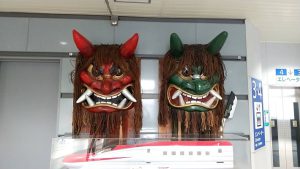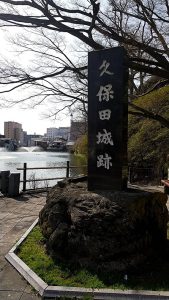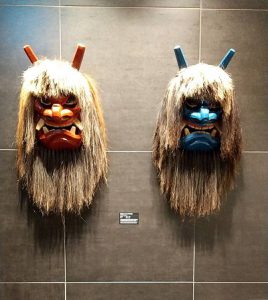なまはげは鬼じゃなかった(愛知県名古屋市千種区姫池通 骨董買取いたします 古美術風光舎名古屋店)
2022.04.16
皆さまこんにちは
秋田県に何かと縁のある、スタッフNでございます。
皆さま、秋田県というと何を思い浮かべるでしょうか?
きりたんぽ鍋、秋田犬、あきたこまち、佐々木希、いぶりがっこ、稲庭うどん等々ございます。
俳優の柳葉敏郎さんは、地元の祭りやイベントによく参加されているそうです。
知り合いの中で柳葉敏郎さんに会えていないのは私だけなので、いつかお会いしたいものです。
そういえば、幼い頃に大曲の花火大会に参加したことがあるのですが、真下から見る花火の迫力は凄まじいものでした。花火の中にいる錯覚に陥るので、是非皆さまにも体験していただきたいです。

今回は、秋田の知人からなまはげの写真を送っていただいたので、なまはげについて詳しくご紹介したいと思います。
空港でご対面するこのなまはげを見ると、秋田県に来た感じが致します。
なまはげは、秋田県の男鹿半島周辺で行われてきた年中行事、あるいはその行事において、仮面をつけ藁の衣装をまとった神の使い(来訪神)のことを指します。
秋田県の男鹿半島(男鹿市)、および、山本郡三種町・潟上市の一部において見られる伝統的な民俗行事で、200年以上の歴史がございます。。男鹿市などの調査によると、2012~2015年において市内148地区のうち約80地区でナマハゲ(なまはげ)行事があるそうです。「男鹿(おが)のナマハゲ」として、国の重要無形民俗文化財に指定されているほか、「来訪神:仮面・仮装の神々」の一つとしてユネスコの無形文化遺産に登録されております。異形の仮面をつけ、藁などで作った衣装をまとった「なまはげ」が、家々を巡って厄払いをしたり、怠け者を諭したりする光景は有名ですよね。
なまはげと同様の行事は日本各地にございますが、その中でも特になまはげは、圧倒的な知名度を得て、秋田県と言えばなまはげと言われるまでに至りました。その知名度の大きさから、秋田県の観光PRに用いられるのは勿論、秋田県に関連する私企業でもモチーフにされたり、秋田県関連の物販・飲食店でのオーナメントや余興の1つとされたりして、頻繁に用いられています。
本来、地区の未婚の男性がなまはげを務めるのが習わしですが、高齢化と地区の人口減により担い手の若者が減少、既婚男性や高齢者、さらには帰省中の親族など地区外の者が務める例も見られるようになりました。男鹿市の双六地区では、なまはげ役を県内にある秋田大学や国際教養大学の外国人留学生も務めることがあるそうです。海外の方にとっては貴重な経験でございますね。また、なまはげの主な訪問先である子供がいる世帯が少子化により減少しているため、実施する動機の減退も見られております。その他、年末年始に仕事があったり、旅行などで不在だったりと、住民の生活の変化もなまはげの衰退の要因になっているそうです。
なまはげには角があるため、鬼であると誤解されることがあるが、鬼ではないそうです。今回調べてみて一番驚きました。なまはげは本来、鬼とは無縁の来訪神でありましたが、近代化の過程で鬼と混同され、誤解が解けないまま鬼の一種に組み込まれ、変容してしまったという説があるそうです。
冬に囲炉裏(いろり)にあたっていると手足に「ナモミ」 「アマ」と呼ばれる低温火傷(温熱性紅斑)ができることがあります。“それを剥いで”怠け者を懲らしめ、災いをはらい祝福を与えるという意味での「ナモミ剥ぎ」から「なまはげ」 「アマハゲ」 「アマメハギ」 「ナモミハギ」などと呼ばれるようになったそうです。
なまはげの仮面の形は地域によって様々異なりますが、赤面と青面の1対に定型化もされており、この場合は赤面がジジナマハゲ、青面がババナマハゲと呼ばれています。
赤青それぞれに名前があったのですね。
「なまはげ」は怠惰や不和などの悪事を諌め、災いを祓いにやってくる来訪神でございます。かつては小正月(旧暦から新暦に)の行事でしたが、大晦日の行事となり、年の終わりに、大きな出刃包丁(あるいは鉈)を持ち、鬼の面、ケラやミノのような用具、ハバキをまとって、なまはげに扮した村人が家々を訪れ「泣ぐ子(ゴ)は居ねがー」「悪い子(ゴ)は居ねがー」と奇声を発しながら練り歩き、家に入って怠け者や子供、初嫁を探して暴れます。家人は正装をして丁重にこれを出迎え、主人が今年1年の家族のしでかした日常の悪事を釈明するなどした後に酒などをふるまって、送り帰すとされています。
ニュースでなまはげの怖さに大泣きする子供をよく見ますが、こうやって秋田の子供たちは強くなっていくのですね。
妖怪などと同様に民間伝承であるため、正確な発祥などはわかっておりません。秋田には、「漢の武帝が男鹿を訪れ、5匹の鬼を毎日のように使役していたが、正月15日だけは鬼たちが解き放たれて里を荒らし回った」という伝説があり、これをなまはげの起源とする説があるそうです。
知っているようで知らないなまはげ、鬼ではなく神様だとわかれば少しは怖くなくなるかもしれません。
ではでは

Hello everyone
This is Staff N, who has something to do with Akita Prefecture.
What do you think of when you think of Akita Prefecture?
Kiritanpo hotpot, Akita dog, Akitakomachi, Nozomi Sasaki, Iburi-gakko, Inaniwa udon, etc.
Actor Toshiro Yanagiba often participates in local festivals and events.
I’m the only one I know who hasn’t met Toshiro Yanagiba, so I’d love to see him someday.
By the way, I participated in the Omagari Fireworks Festival when I was little, but the power of the fireworks seen from directly below was tremendous. You will feel like you are in the fireworks, so I would like everyone to experience it.
This time, an acquaintance of Akita sent me a picture of Namahage, so I would like to introduce you to Namahage in detail.
When you see this Namahage facing you at the airport, you feel like you are in Akita prefecture.
Namahage refers to a god’s messenger (visiting god) wearing a mask and straw costume at an annual event held around the Oga Peninsula in Akita Prefecture.
It is a traditional folk event found in the Oga Peninsula (Oga City) in Akita Prefecture and part of Mitane Town and Katagami City in Yamamoto District, and has a history of more than 200 years. .. According to a survey by Oga City and others, there are Namahage events in about 80 of the 148 districts in the city from 2012 to 2015. In addition to being designated as an important intangible folk cultural property of the country as “Oga Namahage”, it is also registered as a UNESCO intangible cultural heritage as one of the “visiting gods: gods of masks and costumes”. .. It is famous to see “Namahage” wearing a strange mask and a costume made of straw, etc., going around the houses and reminding the lazy.
There are similar events to Namahage in various parts of Japan, but among them, Namahage has gained overwhelming popularity and has come to be called Namahage in Akita Prefecture. Due to its popularity, it is used not only for tourism promotion in Akita prefecture, but also as a motif for private companies related to Akita prefecture, and it is also regarded as one of the ornaments and entertainment at Akita prefecture related merchandise stores and restaurants. And it is used frequently.
Originally, it is customary for unmarried men in the district to act as namahage, but due to the aging of the population and the declining population of the district, the number of young people who are responsible for it is decreasing, and married men and the elderly, as well as relatives who are returning home, are serving as namahage. You can also see examples. In the Sugoroku district of Oga City, foreign students from Akita University and Akita International University in the prefecture may also play the role of Namahage. It’s a valuable experience for foreigners. In addition, as the number of households with children, which is the main destination for Namahage, is decreasing due to the declining birthrate, the motivation for implementing it is also declining. In addition, changes in the lives of residents, such as having work during the year-end and New Year holidays and being absent due to travel, are also factors in the decline of Namahage.
Namahage has horns, so it is sometimes misunderstood that it is a demon, but it seems that it is not a demon. I was most surprised when I looked it up this time. Namahage was originally a visiting god unrelated to demons, but there is a theory that it was confused with demons in the process of modernization, and was incorporated into a type of demon without being misunderstood and transformed.
If you hit the hearth in winter, you may get low-temperature burns (thermal erythema) called “namomi” or “ama” on your limbs. It is said that it has come to be called “Namahage”, “Amahage”, “Amahage”, “Namomihagi”, etc.
The shape of the namahage mask varies from region to region, but it is also standardized as a pair of blush and blue, in which case the blush is called Jijinamahage and the blue is called Babanamahage.
There was a name for each of red and blue.
“Namahage” is a visiting god who gives up evil things such as laziness and discord and comes to worship disasters. It used to be a New Year’s Eve (from the lunar calendar to the new calendar), but at the end of the year, it has a big deba knife (or hatchet), a demon mask, tools like Kera and Mino, and Habaki. In the meantime, villagers dressed as Namahage visit the houses and parade while making strange voices such as “Crying child (Go) is here” and “Bad child (Go) is here”, and enter the house and be lazy. Looking for a child, the first bride, and rampaging. It is said that the family members dress up and greet them politely, and after the husband explains the daily wrongdoing of his family this year, he drinks alcohol and sends them back.
I often see children crying in the news about the fear of namahage, but this is how Akita’s children get stronger.
Since it is a folklore like youkai, the exact origin is unknown. In Akita, there is a legend that “Han Wudi visited Oga and used five demons on a daily basis, but only on New Year 15th, the demons were unleashed and devastated the village.” There seems to be a theory that this is the origin of Namahage.
Namahage that seems to be known but not known, and if you know that you are a god instead of a demon, you may not be a little scared.
See you soon
*********************
新年度を迎えました。
風光舎では、古美術品や骨董品の他にも絵画や宝石、趣味のお品など様々なジャンルのものを買受しております。
お片付けをされていて、こういうものでもいいのかしらと迷われているものでも、どうぞお気軽にご相談下さいませ。
また風光舎は、出張買取も強化しております。
ご近所はもちろん、愛知県内、岐阜県、三重県その他の県へも出張いたします。
まずは、お電話お待ちしております。
愛知県名古屋市千種区・骨董 買取
『古美術 風光舎 名古屋店』
TEL 052(734)8444
10:00-17:00 OPEN


